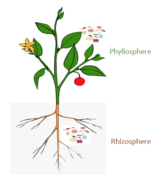| Part of a series on |
| Microbiomes |
|---|
 |
The mycobiome, mycobiota, or fungal microbiome, is the fungal community in and on an organism.[1][2][3]
The word “mycobiome” comes from the ancient Greek μύκης (mukēs), meaning "fungus" with the suffix “biome” derived from the Greek βίος (bíos), meaning “life.” The term was first coined in the 2009 paper by Gillevet et al.[4][5]
Most species of fungi are decomposers with the ability to break down complex polymers. Fungi are commonly found within plant cells in an endophytic relationship or as a pathogen. Most plants also form mutualistic relationships with fungi that accelerate nutrient uptake among their root structures. The most common phyla present in the fungal communities that live alongside animals and in aquatic environments are Ascomycota and Basidiomycota. Animals will typically form a commensal relationship with fungi with the occasional occurrence of a pathogenic interaction.
- ^ Cui L, Morris A, Ghedin E (2013). "The human mycobiome in health and disease". Genome Medicine. 5 (7): 63. doi:10.1186/gm467. PMC 3978422. PMID 23899327.
- ^ Ghannoum M (February 1, 2016). "The Mycobiome". The Scientist. Retrieved February 5, 2016.
- ^ Suhr MJ, Hallen-Adams HE (2015). "The human gut mycobiome: pitfalls and potentials--a mycologist's perspective". Mycologia. 107 (6): 1057–73. doi:10.3852/15-147. PMID 26354806. S2CID 16731371.
- ^ Gillevet PM, Sikaroodi M, Torzilli AP (November 2009). "Analyzing salt-marsh fungal diversity: comparing ARISA fingerprinting with clone sequencing and pyrosequencing". Fungal Ecology. 2 (4): 160–167. doi:10.1016/j.funeco.2009.04.001.
- ^ Gurtler V, Ball AS, Sarvesh S (2019). Nanotechnology (1st ed.). London, United Kingdom. ISBN 978-0-12-814993-5. OCLC 1102320963.
{{cite book}}: CS1 maint: location missing publisher (link)